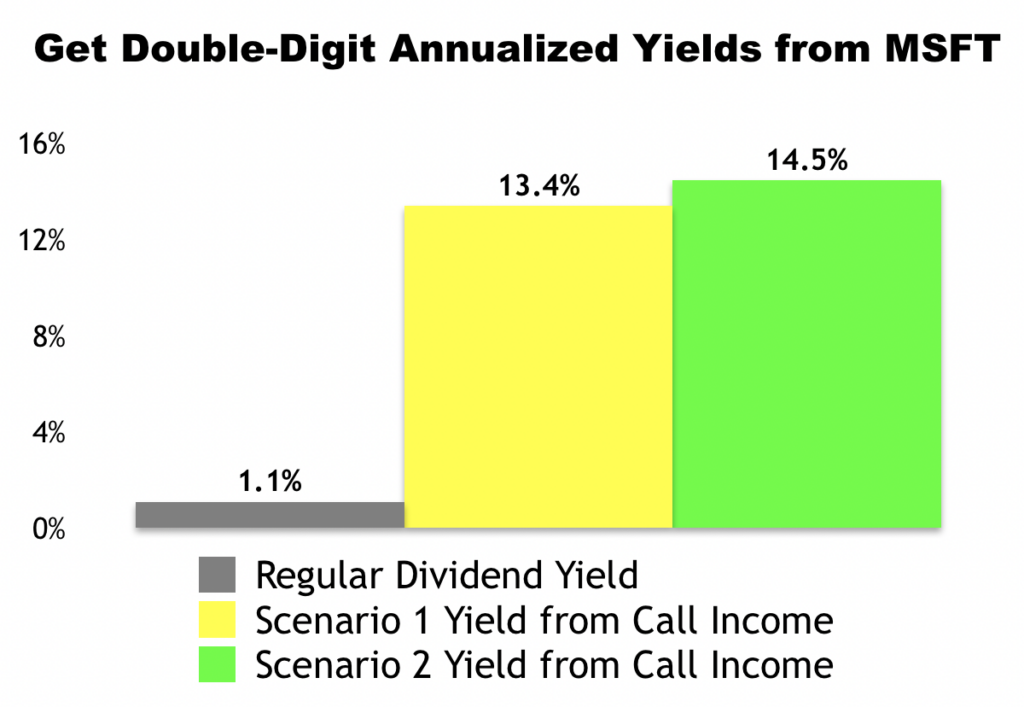In case you missed it, Microsoft (MSFT) just announced it’ll be raising its dividend by roughly 10%…

Source: Microsoft Press Release
Yet despite the double-digit increase, shares will still pay a forward dividend yield of just 1.1%. For many investors — especially those in retirement — it’s hard to live off that kind of income.
That said, if you’re willing to give up most of Microsoft’s upside potential in exchange for a relative safe, ultra-high yield, consider the following opportunity.
In short, we’ll show you how to squeeze 12x more income of out of Microsoft by selling a covered call option… and boost your yield from 1.1% to 13%-plus.
Here’s how…
As we go to press, MSFT is selling for $242.45 per share and the September 15, 2023 $245 calls are going for about $32.00 per share.
Our income trade would involve buying 100 shares of MSFT and simultaneously selling one of those calls.
By selling a call option, we would be giving the buyer of the option the right, but not the obligation, to purchase our 100 shares at $245 per share (the “strike” price) anytime before September 15, 2023 (the contract “expiration” date).
In exchange for that opportunity, the buyer of the option would be paying us $32.00 per share (the “premium”).
There are two likely ways this trade would work out, and they both offer significantly higher income than what we’d collect if we relied on the stock’s dividends alone.

To be conservative, we don’t include any dividends in our calculations for either of the following scenarios. The annualized yields are generated from options premium and applicable capital gains alone. So any dividends collected are just “bonus” that will boost our overall annualized yields even further.
Let’s take a closer look at each scenario…
Scenario #1: MSFT stays under $245 by September 15, 2023
If MSFT stays under $245 by September 15 of next year, our option contract would expire and we’d get to keep our 100 shares.
In the process, we’d receive $3,200 in premium ($32 x 100 shares).
That income would be collected instantly, when the trade opens.
Excluding any commissions, if “Scenario 1” plays out, we’d receive a 13.2% return in the form of income for selling the covered call ($32 / $242.45). Since we’d be in the trade for 360 days, this scenario would work out to a 13.4% annualized yield.
Scenario #2: MSFT climbs over $245 by September 15, 2023
If MSFT climbs over $245 by September 15, our 100 shares would get sold (“called away”) at $245 per share.
In “Scenario 2” — like “Scenario 1” — we’d collect an instant $3,200 in premium ($32 x 100 shares) when the trade opens. We’d also generate $255 in capital gains when the trade closes because we’d be buying 100 shares at $242.45 and selling them at $245.
In this scenario, excluding any commissions, we’d be looking at a $3,455 profit.
From a percentage standpoint, this scenario would deliver an instant 13.2% in income for selling the covered call ($32 / $242.45) and a 1.1% return from capital gains ($2.55 / $242.45).
At the end of the day, we’d be looking at a 14.5% annualized yield from MSFT.
Here’s how we’d make the trade…
We’d place a “Buy-Write” options order with a Net Debit price of as close to $210.45 ($242.45 – $32) as we can get — the lower the better. Options contracts work in 100-share blocks, so we’d have to buy at least 100 shares of Microsoft (MSFT) for this trade. For every 100 shares we’d buy, we’d “Sell to Open” one options contract using a limit order. Accounting for the $3,200 in premium we’d collect, that would require a minimum investment of $21,045.
Hope this helps!
Phil Lamanna and Greg Patrick
The old way of investing in tech giants is over. A NEW strategy unlocks 146X more income on the SAME underlying stocks (like Meta, Apple, and Amazon) -- WITHOUT options trading. Click here to uncover the NEW MAG-7 alternative.
P.S.. We’d only make this trade if: 1) we wanted to own the underlying stock anyways 2) we believed it was trading at a reasonable price 3) we were comfortable owning it for the long-haul in case the price drops significantly below our cost basis by expiration and 4) we were comfortable letting it go if shares get called away. To be mindful of position sizing, except in rare cases, the value of this trade wouldn’t exceed 5% of our total portfolio value. In addition, to minimize taxes and tax paperwork, we would most likely make this trade in a retirement account, such as an IRA or 401(k).
Please note: We’re not registered financial advisors and these aren’t specific recommendations for you as an individual. Each of our readers have different financial situations, risk tolerance, goals, time frames, etc. You should also be aware that some of the trade details (specifically stock prices and options premiums) are certain to change from the time we do our research, to the time we publish our article, to the time you’re alerted about it. So please don’t attempt to make this trade yourself without first doing your own due diligence and research.
Source: Trades of the Day

